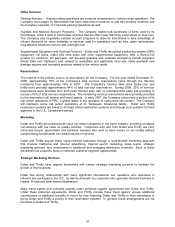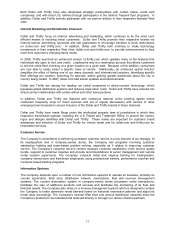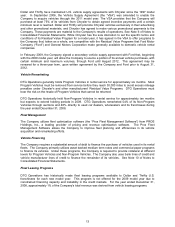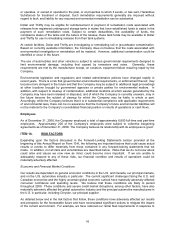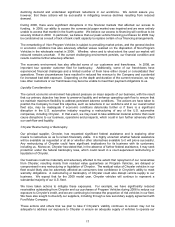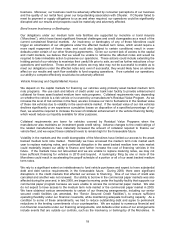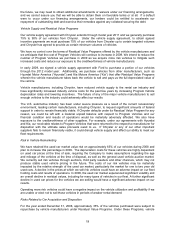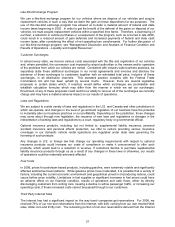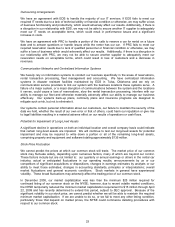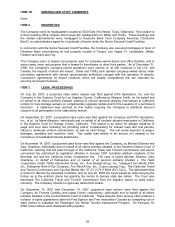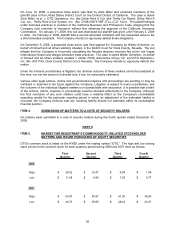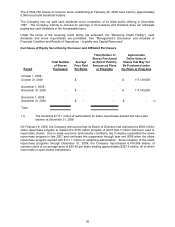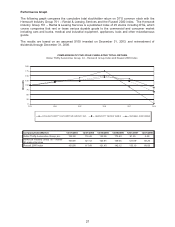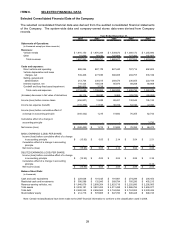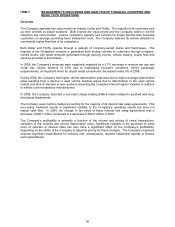Thrifty Car Rental 2008 Annual Report Download - page 22
Download and view the complete annual report
Please find page 22 of the 2008 Thrifty Car Rental annual report below. You can navigate through the pages in the report by either clicking on the pages listed below, or by using the keyword search tool below to find specific information within the annual report.manufacturers agree to repurchase vehicles at a specified price or guarantee the depreciation rate on the
vehicles during a specified time period, typically subject to certain vehicle condition and mileage
requirements. These Programs limit the risk to us that the market value of a vehicle at the time of its
disposition will be less than its estimated residual value at such time.
Residual Value Programs enable us to determine our depreciation expense in advance. This predictability
is useful to us, since depreciation is a significant cost factor in our operations. A trade-off we face when
we purchase Program Vehicles is that we typically pay the manufacturer of a Program Vehicle more than
we would pay to buy the same vehicle as a Non-Program Vehicle. Program Vehicles thus involve a
larger initial investment than their risk counterparts. If a Program Vehicle is damaged or otherwise
becomes ineligible for return or sale under the relevant program, our loss upon the disposition of the
vehicle will be larger than if the vehicle had been a risk vehicle, because our initial investment in the
vehicle was larger. Program Vehicles also expose us to the receivable risk related to the financial
stability of the vehicle manufacturer. If a vehicle manufacturer with a significant receivable balance was
unable to pay amounts owed to us upon the sale of the Program Vehicle, it could materially impact our
financial results and cash flows.
Residual Value Programs generally provide us with flexibility to reduce the size of our fleet by returning
vehicles sooner than originally expected without risk of loss in the event of an economic downturn or to
respond to changes in rental demand. This flexibility has been reduced as the percentage of Program
Vehicles in our vehicle rental fleet has decreased materially. In addition, the increase in the percentage
of risk vehicles in our fleet exposes us to higher residual value risk and unpredictable auction market
conditions.
Highly Competitive Nature of the Vehicle Rental Industry
There is intense competition in the vehicle rental industry, especially on price and service. The Internet
has increased brand exposure and gives more details on rental prices to consumers and increases price
competition. The vehicle rental industry primarily consists of eight major brands, all of which compete
strongly for rental customers. A significant increase in industry capacity or a reduction in overall demand
could adversely affect our ability to maintain or increase rental rates or market share.
Dependence on Air Travel
We get approximately 90% of our rental revenues from airport locations and airport arriving customers.
The number of airline passengers has a significant impact on our business. Mergers and acquisitions in
the airline industry, airline restructuring through bankruptcy, and continued challenging economic
conditions may cause airlines to reduce flight schedules which could adversely impact the number of
airline passengers. The airline industry has also faced considerable challenges in light of current global
economic conditions and an overall decline in air travel. In 2008, airline enplanements decreased nearly
5%. A significant reduction in airline passengers or any event that significantly disrupts air travel could
negatively impact our results.
Concentration in Leisure Destinations
We have a significant presence in key leisure destinations and earn a large portion of our revenue from
these markets. Rental revenue from Florida, Hawaii, California and Texas represented approximately
55% of our total rental revenue in 2008. The severe decline in consumer spending in recent periods has
materially adversely affected leisure travel and can be expected to continue to do so in the foreseeable
future. Reductions in leisure travel resulting from natural disasters, terrorist acts, or other factors could
also have a material adverse impact on our results.
Seasonality
Our business is subject to seasonal variations in customer demand, with the summer vacation period
representing the peak season for vehicle rentals. In 2008, the second and third quarters accounted for
over 26% and 29% of the Company’s vehicle rental revenues, respectively. Any event that disrupts rental
activity, fleet supply, or industry fleet capacity during these quarters could have a disproportionately
material adverse effect on our liquidity, our cash flows and/or our results of operations.
20


